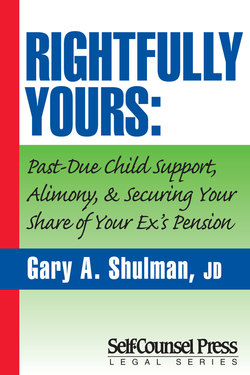Читать книгу Rightfully Yours - Gary A. Shulman - Страница 20
На сайте Литреса книга снята с продажи.
5. The Requirements of a QDRO
ОглавлениеWhen the federal pension law known as ERISA was amended in 1984 to create QDROs, us Congressman Dan Rostenkowski of the Committee on Ways and Means said that:
the bill to amend ERISA would improve the delivery of retirement benefits and provide for greater equity under the private pension plans for workers and their spouses and dependents by taking into account changes in work patterns, the status of marriage as an economic partnership and the substantial contribution to that partnership of spouses who work both in and outside the home.
For the first time, companies across America were required to honor a court order that qualified as a QDRO for the purpose of providing former spouses with a portion of their employee pension benefits.
The term Qualified Domestic Relations Order (QDRO) refers to a judgment, decree, or other court order that creates or recognizes the existence of an “alternate payee’s” right to receive all or a portion of a plan participant’s pension benefits. In other words, a QDRO is a special kind of court order that is signed by the judge and sent to the plan administrator for review and processing. The court, however, will not forward the QDRO to the plan administrator. This must be done by you or your attorney. Remember, the purpose of a QDRO is to make sure that when the time comes, the plan administrator sends you a check for your share of the pension or 401(k) benefits earned during the marriage.
Under a QDRO, you, the nonparticipant spouse, are referred to as an “alternate payee.” Your ex-husband is considered the “plan participant.” Although the best time to draft the QDRO is when you divorce, it is possible to draft a QDRO later, as long as your ex-husband is still alive. But to guarantee that you will get your share of a defined benefit pension for your entire lifetime, the QDRO must certainly be prepared and approved by the plan administrator before your ex-husband retires.
All of the information that must be included in a QDRO can be found in Section 414(p) of the Internal Revenue Code and in Section 206(d) of ERISA. Although the entire QDRO provisions of the law take up only several pages, they may as well be War and Peace as far as divorce attorneys are concerned. These several pages are very difficult for divorce attorneys to understand. Divorce attorneys are intimidated, and for good reason, by ERISA and the Internal Revenue Code. These documents read like Greek to most attorneys, because attorneys are like doctors: they often specialize in one area of the law, just as doctors specialize in one area of medicine. While it’s true that good divorce attorneys will understand the critical need for a QDRO, they may not know how to properly draft one. This is because they are not pension or tax attorneys. But diligent divorce attorneys will hire an outside expert to draft the QDRO if they are not proficient at it, because they are well aware of the downside to not drafting the QDRO at the time of divorce. Divorce attorneys could leave themselves open to a potential malpractice suit years later if their clients never receive the rightful share of pension benefits awarded to them at the time of divorce. Hundreds of thousands of these time bombs are scattered across the country today, residing in attorneys’ files. These are cases in which attorneys did not prepare the QDRO even though their clients were awarded a share of the participants’ pension or savings plan benefits at divorce.
In order for a QDRO to qualify and be approved by the pension plan administrator, it must include certain legally required information:
• The name and last-known mailing address of the plan participant (your ex-husband)
• The name and last-known mailing address of the alternate payee (you, or your child in the case of a QDRO for child support purposes)
• The amount or percentage of the participant’s benefits to be paid by the plan to the alternate payee
• The number of payments or the time period over which such payments are to be made to the alternate payee
• The specific name of the employer’s pension plan
In addition, the QDRO must be:
• For child support, alimony, or property rights to a spouse, former spouse, child, or other dependent of a plan participant
• A court order, judgment, or decree signed by a judge in a domestic relations proceeding, such as a divorce, dissolution, or legal separation
